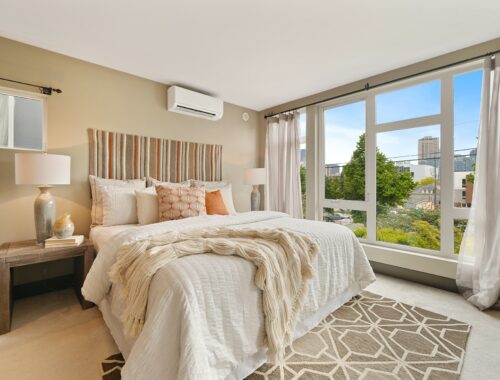Having an energy-efficient, green home is a growing trend for people who are remodeling or building new homes. Many people believe that this practice requires a great deal of technology and even greater amounts of money. However, even people who do not have thousands of dollars for new tankless water heaters and energy-efficient HVAC systems can find simple, effective ways to green their homes.
How to Conserve Electricity
Purchasing multiple Energy Star products is one of the easiest ways to go green. In fact, some Energy Star products give homeowners tax deductions in April. The Energy Star label is easy to find on electronics, appliances and home building supplies. Products with this label are made following stringent guidelines put into effect by the United States Environmental Protection Agency. A few of the many products that have Energy Star certification and that will save homeowners large amounts of electricity over time include computers, televisions, water heaters, light fixtures, air conditioner units, heat pumps, refrigerators, dishwashers and cordless telephones.
Another simple way to save electricity without spending a great deal of money is to switch to compact fluorescent bulbs throughout the house. Each Energy Star light bulb that replaces a traditional incandescent light bulb can save the homeowner $6 per year in electrical costs. Although many people did not like the color and light quality of these compact fluorescent bulbs when they were first introduced, developers have since made great improvements in them. The light from many of these bulbs is now indistinguishable from incandescent light.
In addition, homeowners should always be careful to unplug electronics, chargers and small appliances when they are not using them. Each of these electric devices can sap small amounts of energy from the electrical socket. Over time, unplugging these devices can equal great savings in electricity. The best way to unplug electronics and chargers when they are not being used is to use a power strip that has a single power button that can be switched on and off.
How to Conserve Heat
Learning how to conserve heat during cold winter months will help save natural gas and electricity, depending on the type of heat that one uses. The first way to do this is to invest in sufficient amount of insulation, particularly in the roof or attic of the house. The amount of insulation that one needs depends on the area of the country in which he or she lives. This is measured in something called R-value. Some homeowners may find that their heating and even their cooling bills will go down drastically after they add insulation to their attics. There are several other ways to keep heat from escaping out of the house. One is to replace old windows and doors with Energy Star qualified products. Another is to install new weatherstripping around windows and doors where the old weatherstripping has become hard or has cracked and broken away. A final option is to caulk around ducts and pipes that lead into the home.
Changing to a programmable thermostat is another admirable and cost-effective solution. Programmable thermostats allow homeowners to decrease the temperature in their homes during the night while they are sleeping or during the day when they are at work. The heat will then increase automatically at a specified time. These thermostats can keep numerous temperature settings and times in their memories. They can also be used during the summer to decrease energy consumption when people are away from home.
How to Conserve Water
What is surprising to many people is that using a dishwasher is far cheaper than it is to do a load of dishes by hand. This is true even if the dishwasher is not quite full. In fact, an Energy Star dishwasher can save the average homeowner around 5,000 gallons of water each year versus washing by hand. Another way to save with a dishwasher is to rinse dishes before loading them and to choose the light wash cycle.
However, toilets are what consume the most water in average homes. In fact, toilets use approximately 30 percent of the waterthat comes into a house. If a toilet is leaky, even more water will be used. Homeowners should immediately address leaky toilets or toilets that run for a long time. The best option is to switch to a WaterSense toilet, which can save around 2.5 gallons of water per flush. Those who want to go green completely can try a composting toilet, which uses virtually no water.
Homeowners can also conserve water by repairing leaky faucets, installing new aerators and switching to low-flow showerheads. An aerator does not cost much and can be screwed onto a faucet quite simply; new aerators can slow the flow of water to a more efficient level. Those living in older houses may have showerheads that use over five gallons of water per minute. Switching to a new high-efficiency showerhead can cut this number in half and save thousands of gallons of water each year.
How to Build with Sustainable Materials
Those remodeling an older home or building a new home will want to make sure that they are using green building materials. Bamboo is an excellent choice for flooring, countertops and more because it is a fast-growing plant. Another excellent choice is flooring made from recycled sources; many supplies come from recycled materials, including ceramic tiles, rubber flooring and stone. Some people choose to use reclaimed lumber from older houses in the true spirit of recycling. Finally, cork is a trendy green flooring option that is perfect for kitchens.
Making changes in one’s home to go green does not have to be a long, costly endeavor. In fact, any average homeowner can do it in numerous ways, whether the homeowner is building a new home, remodeling an older home or just looking to make some small changes. Going green can even save money and make life easier over time.
Great Resources for Making Your Home Eco-Friendly:
9 Ways to Make Your Home More Energy-Efficient
12 Easy Ways to Green Your Home
10 Ways to Green Your Home
How To Make Every Room In Your Home More Eco-Friendly
40 ways to go greener at home …besides just recycling
Green Building Information
Green property: George Clarke’s top 20 ways to make your home eco-friendly






